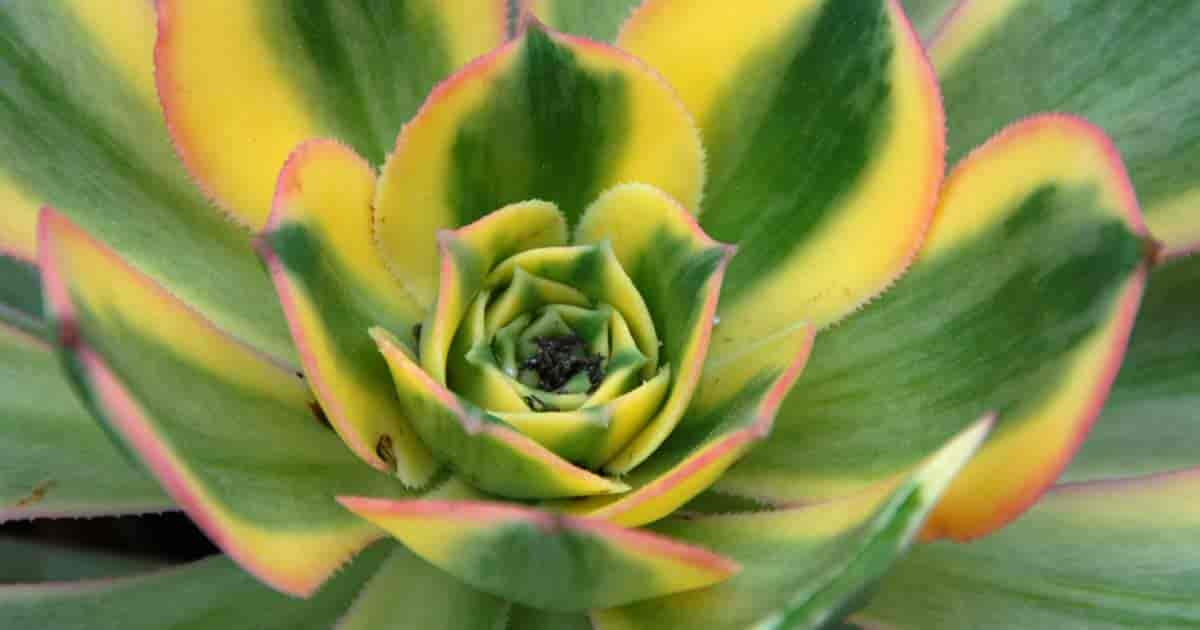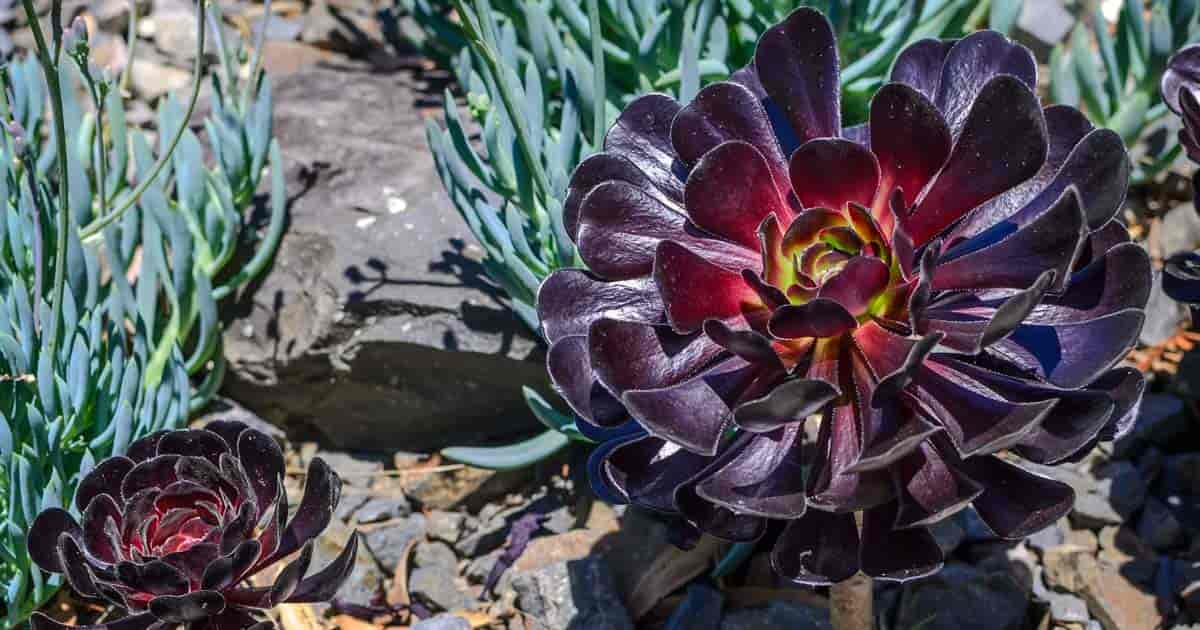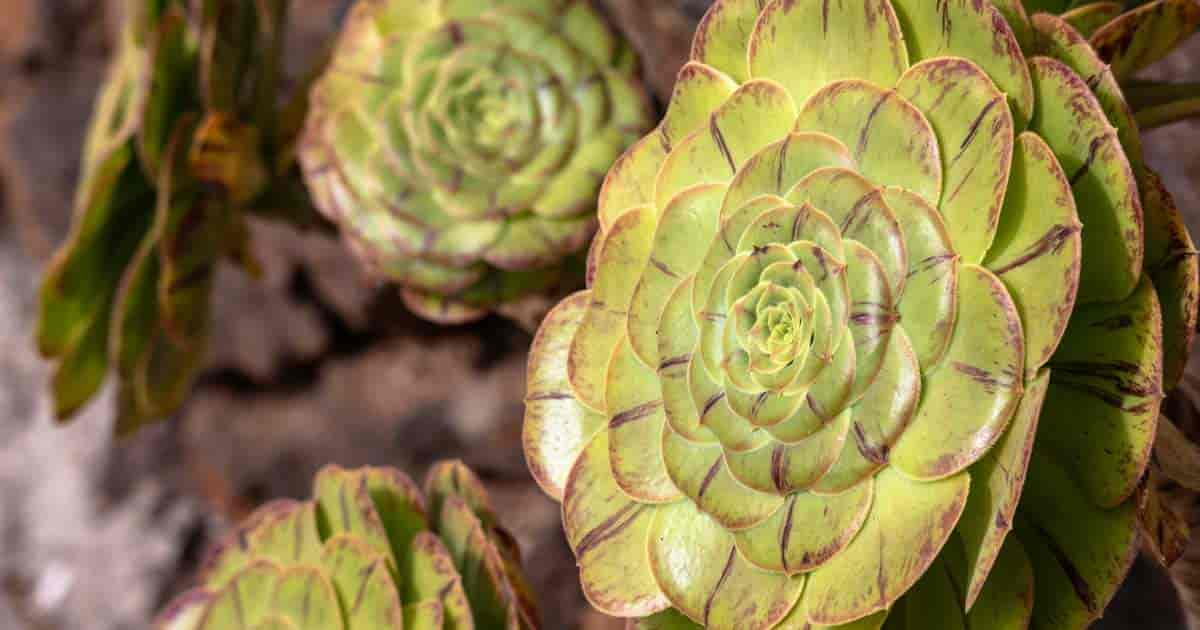Aeoniums are colorful, attractive, evergreen rosette type of succulents hailing from the Canary Islands.
They are very popular in xeriscapes and in general use in landscaping in desert settings.
Aeonium Arboreum ‘Zwartkop’ growing in the landscape
They can also be grown indoors in containers as long as ample light is available.
There are approximately 40 aeonium species, as well as numerous cultivars and hybrids.
In this article, we discuss this interesting succulent and share advice to help you enjoy success with Aeoniums in your home, yard or garden. Read on to learn more.
Where Did The Name “Aeonium” Come From?
The plant’s botanical name Aeonium comes from the Greek word, aionos, which means “ageless.”
Aeonium plants seem to be ageless as new rosettes take the place of those that bloom and die.
The common name of this entire genus is “Tree Houseleek” because of its growth habit.
For the most part, it grows on a stalk or trunk rather than nestling close to the ground as do similar succulents.
Are Aeoniums Hard To Grow?
The plants readily available for cultivation tend to be easy-keepers. They branch freely and perform well even for beginning gardeners.
They make an exciting addition to any collection because of the array of colors they display.
Foliage transitions through shades of green, yellow, purple and red seasonally. Additionally, these plants may flower from time-to-time.
Blossoms may be white, yellow, pink or red. The pretty, colorful flowers are attractive to bees and other pollinators.
When one rosette finishes flowering, it dies, but surrounding rosettes live on. One cultivar (Aeonium simsii) does not die after flowering.
How Do Aeoniums Change Seasonally
In the Canary Islands the winters are wet and the summers are dry. These weather patterns cause Aeoniums to display seasonal changes.
They grow the most during the autumn, winter and spring. They rest in the heat of the summer.
For this reason, these plants have fewer and smaller leaves during the summer months. Their leaves are often closed during this hot, dry time as a way of saving moisture.
In times of drought or high sun, they may turn purple or red.
These are normal reactions to the hot, dry months of summer, so you should not be alarmed or try to correct the situation.
Respect the natural cycle of the plant. Don’t give it extra water during the summer.
Just let the plant rest. In wintertime, when most other types of plants rest, the Aeonium grows and will need more bright light and more water.
What Does Aeonium Look Like?
It is fairly accurate to say that most Aeoniums kept under cultivation are hybrids or cultivars.
 Aeonium decorum ‘Sunburst’
Aeonium decorum ‘Sunburst’
Some of the most common are:
- Aeonium arboreum ‘Zwartkop’, with its pretty purple leaves
- Aeonium decorum ‘Sunburst’ with variegated leaves
- Aeonium cyclops features dark bronzed burgundy rosette petals
- Aeonium haworthia ‘Kiwi’, which also has variegated leaves
Aside from these, it is hard to tell one type of Aeonium from another as many of those readily available for cultivation are quite similar.
Standard indicators of type (e.g. size and color) tend to be unreliable in cultivated specimens. Appearance and size may vary a great deal depending upon:
- The time of year,
- The amount of sun a plant receives,
- Watering and fertilizing habits of the caretaker
- The type and size of container the plant is grown in
Even so, there are a few clues to help you with identification of Aeoniums.
#1 – Marginal Hairs: When attempting to identify the species, cultivar or hybrid sitting before you, one clue can be the fine hairs which grow on the leaf margins.
These distinguish the plants from other New World succulents with a rosette growth habit, such as Echeverias.
#2 – Thin Leaves: Another difference between Aeoniums and other types of succulents lies in the thickness of the leaves. For the most part, these plants have rather thin leaves.
#3 – Marginal Bumps: There are two exceptions to both of these identifying factors, though.
Both Aeonium Nobile and Aeonium Sedifolium have thick leaves and no marginal hairs. Look for small bumps where the marginal hairs would be to identify these two cultivars.
#4 – Tall Stems: Aeoniums allowed to grow freely in the ground usually stand up on a tall stem, but one variety (Aeonium Tabuliforme) grows in a mound like an Echeveria.
Furthermore, all Aeoniums kept in pots tend to have short, stunted stems.
#5 – Unusual Blossoms: Unlike many other rosette-growth succulent plants, the flowers of this plant have free petals divided into six or twelve sections.
Rosettes blossom from the center one time, then the individual rosette dies back. Surrounding rosettes (offsets) take its place.
#6 – Seasonal Color Variations: The leaves are often colorful and may be green, variegated, yellow, white, pink or even red.
Aeoniums offer seasonal color and interest as their leaves darken and furl for summer, then open up, plump up and produce blossoms during the active months of autumn, winter and spring.
What Are The Different Kinds Of Aeonium?
The various hybrids and cultivars are innumerable.
The fact that this plant readily naturalizes in conducive settings means that many hybrids have simply sprung up on their own.
Here is a nice collection of many different types of Aeoniums.
What Are Some Of The Best Varieties Of Aeoniums?
Aeonium Sunburst (Aeonium david bramwelli) is a large, slightly frost-resistant hybrid with rosettes that can attain a width of one foot.
The colorful leaves are light yellow with green and white stripes and pink tips.
Aeonium Blushing Beauty has short, thick stems and very tight rosette clusters. Leaves are green with pink edging. The plant is cold tolerant to 25° degrees Fahrenheit.
Aeonium haworthii (Pinwheel plant) shrubby 2′ foot tall plant, blue-green leaves, while leaf edges are red. Has white flowers.
Kiwi/Tricolor a sport of (Aeonium haworthii) is very easy to grow and produces showy, four-inch flowers that transition in color from pale yellow to green or red.
Aeonium arboreum ‘Zwartkop’, leaves also darken during the summer months. The leaves of this plant become nearly black.
 Aeonium Atropurpureum leaves turn purple during the hot, dry, bright months of summer.
Aeonium Atropurpureum leaves turn purple during the hot, dry, bright months of summer.
Aeonium arboreum forms bright green rosettes atop branching stems.
Aeonium Garnet is a Zwartkop hybrid which produces red leaves.
Of these, only Blushing Beauty, Sunburst and Zwartkop have been recognized by the Royal Horticultural Society with the Award of Garden Merit.
For more information about the multitudinous varieties of Aeoniums available to collectors, see the Royal Horticultural Society’s extensive and detailed listings: Find a plant – Aeonium
What Other Succulent Varieties Are Related To Aeoniums?
Cousins of the Aeonium include:
- Sempervivum
- Crassulaceae
- Monanthes
- Aichryson
- Greenovia
How Do You Care For Aeoniums?
These plants are easy to grow in sandy, well-drained soil kept at a dry-to-medium moisture level.
Generally speaking, they can do well with standard succulent care. While they can do well kept indoors, they are mostly happier outdoors.
USDA Hardiness Zones: Most of these plants will only do well in zones 9-11.
Some varieties can tolerate light frost. Some varieties can do well with light frost and many are hardy at temperatures as low as 28°-30° degrees Fahrenheit.
In colder climates, these plants do well in containers kept indoors on a sunny windowsill through the colder months.
Sun Requirements: Depending on the intensity of the sun in your area, they like a partial shade to full-sun setting.
Water Requirements: During the semi-dormant summer months, your plant will require little or no water. Don’t allow it to dry out completely.
Don’t be alarmed if the leaves curl up during very hot, dry weather. This is an evolutionary adaptation that helps the plant conserve water.
During the wintertime, test the soil with your fingertip from time-to-time.
If the top inch of soil is dry, water generously. Allow excess water to drain out.
Wait until the soil is dry again for the next watering. Remember that excessive water causes root rot in all succulents.
Soil Requirements: Many collectors report having better luck with a standard potting mix or sandy loam than with specially prepared cactus mix or succulent soil.
A good, light potting mix will hold a slight amount of moisture around the roots without excessive sogginess.
Repotting: Because they do not have an extensive root system, these plants typically only need to be repotted every two or three years.
Repot in the fall, at the beginning of the growing season. Shake all old soil off the roots and replace it with fresh, new soil.
Fertilizer Requirements: During the growing season, provide a half strength dose of balanced, water soluble fertilizer once every month to six weeks.
During the summertime, do not fertilize.
10 Tips For Growing Healthy Aeoniums
#1 – Your main focus in caring for these plants should be in setting up an ideal environment. If the plants are happy in their setting, they need very little care.
In fact, they do quite well when left to their own devices in a balanced, outdoor setting.
#2 – When thinking about placement for your plant, keep your climate in mind.
These plants hail from sunny, mild Mediterranean settings, so they are not well-suited to extremes in heat and cold.
#3 – If your area has cold (not sub-zero) winters, place your plant in a sheltered area where it will be protected from strong, cold winds.
In areas that freeze, these plants must be overwintered indoors in a location that gets bright sun. You may need to supplement with artificial light.
#4 – If you live in an area that has harsh sun, place your plant in a way that allows for shade during the hottest parts of the day.
#5 – If you live in an area that has a great deal of rainfall, plant your Aeoniums on a slope with very well-draining (even rocky) soil to prevent having your plants stand in water.
#6 – In climates that do not allow these plants to naturalize, you must pay close attention to the temperature and amount of sun and rain they receive.
In this sort of setting, it’s best to keep them as container plants and move them about as needed to provide protection from extremes in weather.
#7 – When kept as potted plants, they don’t need much space; however, when planted in the ground, they tend to spread out so ample growing room is desirable.
#8 – Because Aeonium store water in their stems and leaves, their root systems are quite shallow. If your plant is root bound, you may notice new roots growing from the stems.
This means your plant needs to be repotted. If your plant begins dropping stems, this also indicates a need for a new and larger pot. Keep those fallen stems! If you set them on the surface of some good, well-drained soil, they will sprout roots and grow into new plants.
#9 – When these plants grow tall and leggy, the weight of the rosettes at the top of the stem may cause the plant to fall over and the stem to break. Don’t despair! Now you have two (or more) plants.
The bare stem sticking out of the soil will soon produce more rosettes. Meanwhile, you can simply poke the broken stem into a pot of slightly moist potting soil, and it will take root and grow. You can lighten its load by removing excessive rosettes and providing them with their own pots as well.
#10 – If your Aeoniums’ bottom leaves start drooping and falling off, don’t despair. This is normal. As new leaves grow on the top, old leaves fall off the bottom.
Even if your plant loses all it’s leaves during the summer, don’t be too alarmed. It may have just gone dormant due to the heat. Just leave it alone. It will probably rebound when the weather cools.

How Big Do Aeoniums Grow?
There is tremendous variety in size among the members of this genus. Some types naturally grow only a few inches high with rosettes only one or two inches wide.
Other types may grow to be three or four feet high with rosettes the size of a dinner plate. Size depends on a wide variety of factors.
When And How Long Do Aeoniums Bloom?
These plants start blooming late in the winter and may hold their blooms throughout the spring months.
What Pests Bother Aeonium Plants?
The types of insects that typically pester succulent plants can also be bothersome for aeoniums.
Watch out for mealybugs and aphids, which tend to conceal themselves in the folds of the rosette.
You may not know you have a problem with these bugs until ants show up to gather the honeydew (sweet excrement) they produce.
Problems with these two pests tend to be greater for plants in flower.
Additionally, plants kept in containers are more susceptible to infestation than those planted in well-chosen outdoor settings.
In addition to problems caused by aphids, mealybugs and mammals, outdoor Aeoniums may also be preyed upon by slugs.
Remove slugs manually and deflect them with natural repellents such as diatomaceous earth and/or crushed eggshells sprinkled around the beleaguered plant.
Plants in the garden may attract herbivorous mammals.
Rabbits, squirrels, deer and livestock all enjoy eating them. Birds may also eat the juicy, succulent leaves.
This is especially true during periods of drought because the leaves store water.
The need to avoid overwatering cannot be stressed enough. Any plant that is watered too much is subject to pest infestation and rot.
Are Aeoniums Poisonous To Cats And Dogs?
Aeoniums are completely edible for all creatures, humans included!
How Do You Propagate Aeonium?
To start a new plant, just take a cutting below a terminal rosette.
The best time to do this is in the autumn, which is a time of active growth.
If you don’t have a branching plant, you can probably grow a new plant from an intact leaf.
Follow standard leaf-rooting procedures for succulents to have success with this method.
It is also possible to grow these plants from seed.
In fact, in ideal outdoor settings, they are self-seeding. Like many succulents, these plants produce very fine seed.
Seedlings are quite delicate and need overhead protection until they have gained a little size and produced several sets of leaves.
Where Do Aeoniums Grow Wild?
For the most part, they come from the Canary Islands, but there are six species that come from other settings.
- Aeonium Gorgoneum comes from Cape Verde.
- Aeonium Glandulosum comes from Madeira.
- Aeonium Glutinosum comes from Mateira.
- Aeonium Korneliuslemsii comes from Morocco.
- Aeonium Leucoblepharum comes from East Africa.
- Aeonium Stuessy comes from East Africa.
In addition to hybrids and cultivars hailing from these locations, some have also been developed in such diverse settings as California and Yemen.
In the Canary Islands, distribution is varied from one island to the next.
Some islands have no Aeoniums while others may have as many as thirteen species.
In addition to their natural distribution, various cultivars and hybrids have naturalized in mild climates the world over, and they continue to hybridize, adapt and spread.
What Are The Best Ways To Use Aeoniums In The Garden?
These plants make great additions to any succulent garden and do well in combination with agave, jade and aloe plants. Aeonium is a great choice for a rock garden.
Low growing varieties do well as border plants in a sunny garden setting. In colder settings, it’s best to keep them in containers to be overwintered indoors.
For the most dramatic appearance in a garden setting, it’s a good idea to use a mass planting technique.
Because these plants do not have extensive root systems, they don’t need a lot of soil so they can do well as container plants, and this use gives you more control over how the plant grows and how large it becomes.
Tall, large variety as a specimen plant. Kept in a container, these plants have a nice bonsai-like appearance.
Why Choose Aeoniums?
These plants are lovely to look at and easy to care for.
They grow in a dazzling array of colors, sizes, and shapes, yet every variation maintains a classic, attractive rosette leaf formation.
When you set up the perfect environment for one type of Aeonium, it just makes good sense to collect them all – if you can.
Collecting and growing these fascinating plants could easily be a lifelong pursuit. Remember that the variations and hybridizations are endless.
With enough specimens on hand, you could easily develop your own hybrid Aeonium without even trying!
 Aeonium decorum ‘Sunburst’
Aeonium decorum ‘Sunburst’
